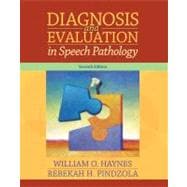
| Introduction to Diagnosis and Evaluation: Philosophical Issues and General Guidelines | |
| Diagnosis and Evaluation Defined | |
| Broadening the Notion of Assessment | |
| Illustrating the Importance of Measurement in Current Trends | |
| The Importance of Functional Measurements: The World Health Organization and ASHA | |
| Diagnosis to Determine the Reality of the Problem | |
| Diagnosis to Determine the Etiology of the Problem | |
| Diagnosis to Provide Clinical Focus | |
| Diagnosis: Science and Art | |
| Diagnosis Versus Eligibility | |
| The Diagnostician as a Factor | |
| The Client-Clinician Relationship | |
| The Client as a Factor: Children, Adolescents, and Adults | |
| Putting the Diagnosis to Work | |
| Precepts Regarding the Clinical Examination | |
| Interviewing | |
| The Importance of Interviewing | |
| The Nature of Interviewing | |
| Common Interviewing Considerations | |
| An Approach to Interviewing | |
| Improving Interviewing Skills | |
| Psychometric Considerations in Diagnosis and Evaluation | |
| Common Types of Tests | |
| Validity: The Foundation of the Test or Measure | |
| Reliability | |
| Some Quantitative Background for the Test Interpretation | |
| Central Tendency, Variance, and the Normal Curve | |
| Sensitivity and Specificity: Key Concepts in Evidence Based Practice | |
| Criteria for Evaluating Standardized Tests | |
| Common Errors in the Use of Norm-Referenced Tests | |
| Conclusion | |
| Assessment of Children with Limited Language | |
| The Process of Becoming a Communicator: Getting the Big Picture | |
| Focusing on the Child's Language Level: Nonverbal, Single Word, and Early Multiword Communicators | |
| Considering Etiology | |
| Why Is Early Language Assessment so Difficult? | |
| Models to Consider in Language Assessment | |
| Theoretical Considerations in Language Assessment | |
| Assessment That Focuses On Early Communication and Variables That Predict Language Growth | |
| Specific Assessment Areas: Procedures, Considerations, and Directions For Further Study | |
| Concluding Remarks | |
| Assessment of School-Age and Adolescent Language Disorders | |
| Use of Standardized Tests with Syntax-Level Children | |
| Nonstandardized Testing | |
| Language Sampling: A General Look at the Process | |
| Later Language Development: Emerging Data | |
| Testing Language Comprehension | |
| Assessment of Syntax Using Analysis Packages | |
| Assessment of Conversational Pragmatics | |
| Evaluating Literacy and School Curriculum | |
| Conclusion | |
| Assessment of Articulation and Phonological Disorders | |
| Multiple Components Contributing to Sound Production | |
| Seven Important Knowledge Areas for Evaluation of Articulation and Phonological Disorders | |
| Overview of the Articulation/Phonology Assessment Process | |
| Traditional Assessment Procedures | |
| Test Procedures that Evaluate Phonetic Context Effects | |
| The Phonetic and Phonemic Inventories | |
| Distinctive Feature Analysis | |
| Phonological Analysis | |
| Assessment of Phonological Knowledge | |
| Other Testing | |
| Integrating Data from the Assessment | |
| Severity and Intelligibility | |
| Computer-Assisted Analysis of Phonology | |
| Long Term Impact of Phonological Disorders | |
| Disorders of Fluency | |
| Differential Diagnosis | |
| The Appraisal of Stuttering | |
| Evaluation at the Onset of Stuttering | |
| Evaluation of the School-Aged Student | |
| Assessment of the Adult Who Stutters | |
| Assessment of Aphasia and Adult Language Disorders | |
| The Nature of Aphasia | |
| Case History | |
| Diagnosis and Formal Testing | |
| Differential Diagnosis | |
| The Art of Informal Assessment | |
| Summing Up the Findings | |
| Motor Speech Disorders, Dysphagia, and the Oral Exam | |
| The Oral Peripheral Examination | |
| Apraxia of Speech in Adults | |
| Developmental Apraxia of Speech | |
| The Adult Dysarthrias | |
| Cer | |
| Table of Contents provided by Publisher. All Rights Reserved. |
The New copy of this book will include any supplemental materials advertised. Please check the title of the book to determine if it should include any access cards, study guides, lab manuals, CDs, etc.
The Used, Rental and eBook copies of this book are not guaranteed to include any supplemental materials. Typically, only the book itself is included. This is true even if the title states it includes any access cards, study guides, lab manuals, CDs, etc.